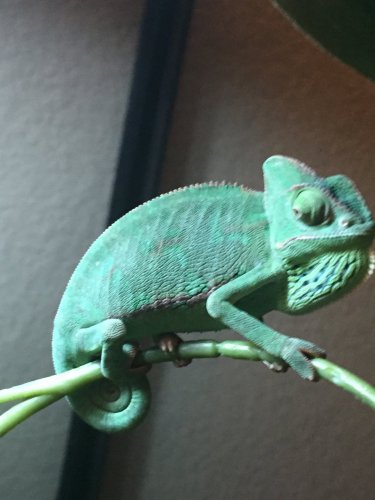Hellbeckons
New Member
Hi, I have had my chameleon for about a month now he is probably about 4 months old. He has only eaten about 20 crickets since I have gotten him. He seems to have an extremely reduced appetite help would be appreciated.
Follow along with the video below to see how to install our site as a web app on your home screen.
Note: This feature may not be available in some browsers.

I would add greens such as dandelion greens, kale, endive, escarole, collards and veggies such as squash, zucchini, sweet red pepper, sweet potatoes, carrots, etc to what you feed/gutload the insects with and drop the orange cubes.
Since most feeder insects have a poor ratio of calcium to phosphorous it's important to dust the insects just before feeding them to the chameleon with a phosphorous-free calcium powder at almost every feeding.
It's recommended that you dust twice a month with a phosphorous-free calcium/D3 powder to ensure that the chameleon gets some D3 without overdosing it and leaving it to produce the rest of the D3 from its exposure to the UVB light. D3 from supplements can build up in the system but D3 produced from exposure to the UVB light won't as long as the chameleon can move in and out of the UVB at will.
It's also recommended that you dust twice a month with a vitamin powder that contains a beta carotene prOformed source of vitamin A. PrOformed sources won't build up in the system like prEformed sources will so this leaves it up to you to decide if/when your chameleon needs prEformed vitamin A.
I would get rid of the purple bulb and use a regular white household incandescent bulb of a wattage that produces a basking temperature in the low to mid 80's F.
Imwould also recommend that you use non toxic real plants since veileds nibble on greenery and you can actually give them the same greens, veggies and fruits that I recommend you feed/gutload the crickets, superworms, etc.
Greens such as dandelion greens, kale, endive, escarole, collards, and veggies such as zucchini, squash, carrots, sweet potato, sweet red pepper, etc and a bit of fruit such as apples, pears, melon, berries, etc.
I would set up a dripper too.
What size are the insects? Will they fit in the chameleons mouth easily?
It's important that you provide the right basking temperature so that the chameleon can digest it's food properly.
Do you use a substrate?
Some of these things may be playing a part in the eating...or not eating rather...but there may be other reason s for it.